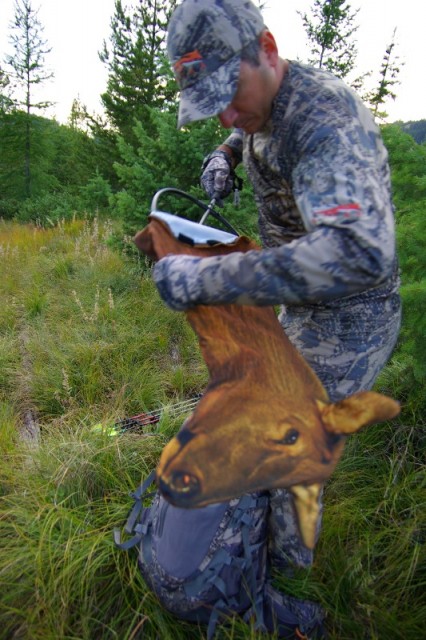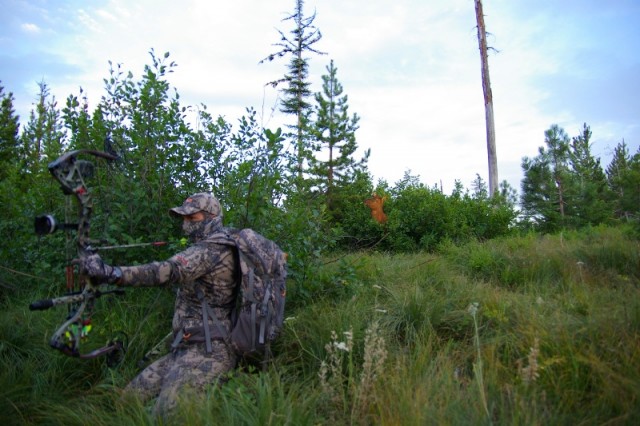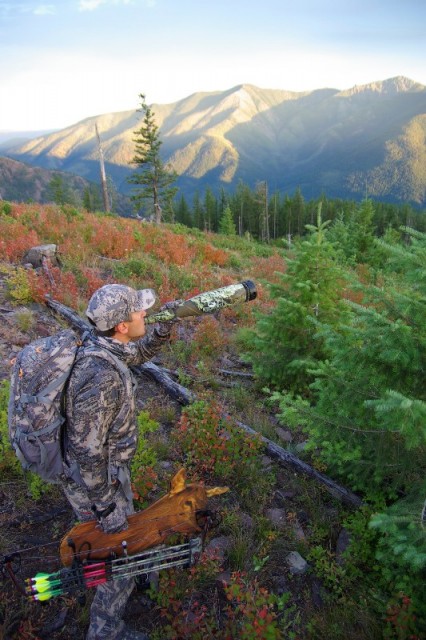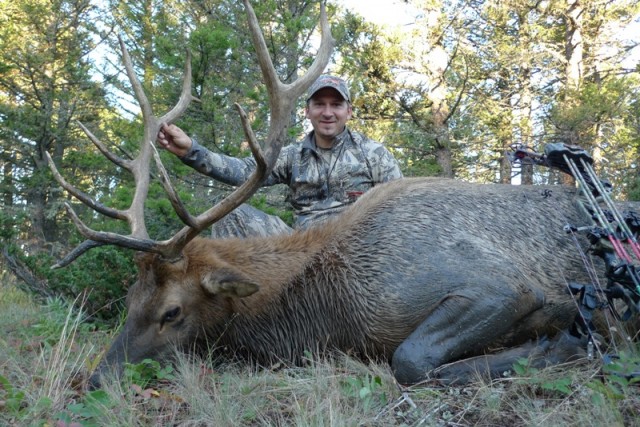Decoys for Elk
 The sage crackled and released its pungent scent with each step through the low-lying shrubs. An occasional bugle drifted toward us through the blackness which taxed our senses even more. As the morning darkness gave way to the sliver of light growing in the east, our trio quickened its pace toward our quarry.
The sage crackled and released its pungent scent with each step through the low-lying shrubs. An occasional bugle drifted toward us through the blackness which taxed our senses even more. As the morning darkness gave way to the sliver of light growing in the east, our trio quickened its pace toward our quarry.
It was early October 2000 and the bulls were still vocal. My two friends and I were excited that the rut was still in high gear. The previous day we located a sizable herd of elk in the lower sage country. The elk would feed and cavort in the open at night and bed in a few select pockets of timbered hillside in the day.
This morning the wind was steady and the bulls were fired up. We crept through a patch of tall sage intermingled with Christmas-tree size fir. Between our patch of cover and the elks’ bedding area was a 200 yard-wide grassy flat that would barely conceal a golf ball.
We decided that it would be tough to call a bull from the timber across this flat since we were basically in the wide open sage. But my friend had brought along a decoy and it was agreed that there was nothing to lose.
As I popped it open both of my buddies slipped forward and set up to the left and to the right. When they were settled in I propped the decoy up so the rump would be visible from the timbered hillside and I let out a few high energy cow squeals. Instantly the timber erupted with bugles and a few seconds later a medium sized 5-point emerged on the edge. He was staring directly at me and the decoy.
I wiggled the fake elk and squealed again. The bull started over at a fast trot. As he pulled up in front of the left side shooter, two smaller bulls started towards us. I watched as an arrow flashed over the top of the first bull. As he ran off the small bulls arrived. I suspect one of them would have died that day if a nice 6-point had not then emerged from the timber edge. He was screaming and running strait for us.
The big 6 ran between both shooters and stopped right in front of the decoy. But because I was hunkered behind the decoy, nobody could shoot towards him! He finally walked away slightly confused about the cow that didn’t respond to his advances. Nobody killed an elk that morning, but with our first decoy experience under our belts we all learned some valuable lessons.
Since that first experience I’ve used decoys every season with varied results. Like any hunting technique they don’t work every time in every place. And like my first experience, every time I use one there is a lesson to be learned.
 So why do they work? Elk use their vision just as much as their other senses and what they do see is just as important as what they don’t. When an elk responds to vocalizations they expect to encounter another elk. After having a few close calls with hunters a lot of public land elk want a visual conformation of vocalizations before they commit to an encounter. This is where the decoy can work wonders. The flash of elk hide in the trees confirms what he is hearing; there is an elk where the sound is coming from.
So why do they work? Elk use their vision just as much as their other senses and what they do see is just as important as what they don’t. When an elk responds to vocalizations they expect to encounter another elk. After having a few close calls with hunters a lot of public land elk want a visual conformation of vocalizations before they commit to an encounter. This is where the decoy can work wonders. The flash of elk hide in the trees confirms what he is hearing; there is an elk where the sound is coming from.
There are several types of decoys on the market these days. They range from full body 2D silhouettes to 3D hats that the hunter wears. I’ve used several of the different makes of the silhouettes and have come to know their strengths and weaknesses.
The most common decoy I see people use is an expandable 2D silhouette. Some are full-body and come with ground stakes that thread into the body for rigidity. Others are head silhouettes that use a small hoop to tension the fabric and have a handle that allows you to clip it to a tree limb or flash it above the brush. Both work well but they have unique strengths.
The stake-in-the-ground types are large and very visible when expanded. Elk can see them from long distances in open country and sparse timber. They are also very realistic with a full-body photo. If there are two or more hunters it helps to have one guy dedicated to running the decoy. As the shooter moves ahead to set up, the caller can deploy the decoy, as well as readjust the set-up when needed. If you are hunting solo it takes more time to deploy and adjust these types of decoys.
I usually use these types when I am hunting the front country due to the weight of the stakes. In order to save a little weight I sometimes tie some cord to the decoy and hang it over a limb or bush. This speeds up deployment but limits where and how you can use it. The set-up is also more susceptible to wind movement. A little movement can be good but too much or the wrong kind can spook an incoming bull.
 The head silhouette decoys like the Heads Up are light and compact. They are great for the solo or back country hunter. The small size makes it easy to carry while expanded and it can be clipped to a bush in seconds. I’ve also heard of guys having success attaching them to their bows via a riser attachment. The few ounces are barely noticeable when shooting in calm conditions.
The head silhouette decoys like the Heads Up are light and compact. They are great for the solo or back country hunter. The small size makes it easy to carry while expanded and it can be clipped to a bush in seconds. I’ve also heard of guys having success attaching them to their bows via a riser attachment. The few ounces are barely noticeable when shooting in calm conditions.
When using a decoy I try to follow a few basic rules. The decoy needs to be visible (but not too visible) to an approaching bull. If he can’t see from his comfort zone he won’t commit to the encounter. I try to think ahead and place it where it is visible from several different angles. Since these are only 2D you will be limited on these angles. If a bull approaches somewhat parallel to the decoy he may never see it.
Don’t make it too visible. If a bull can study the whole decoy from afar he may not be convinced. I like to show just a portion of the decoy. It looks more natural and there is less for the bull to scrutinize. With a head silhouette this is your only option.
Add some natural movement to your decoy. Slide it sideways behind some open brush or show the head between small trees. They key is to make the movement slow yet noticeable. Don’t let it blow around in the breeze. Also don’t flap it around like you’re flagging in geese. Think about how an elk looks when you see it moving naturally through the forest and try to emulate that.
Even after all these years decoying elk I still am learning and still screwing up. September of 2010 found me hunting solo with my full-body decoy. I worked in on a talkative bull and got a visual on him. I propped up the decoy, made a hasty cow call, moved laterally, and readied for an encounter. While I was focusing out in front of the decoy I caught some movement directly to my left. I swiveled on my knees just as a 5×6 rack rose from a small draw 30 yards away.
 I could see slobber dripping from his mouth in the early morning sunshine as he stared at my decoy. It was facing 90 degrees the wrong way and he could not tell what it was. While he was trying to figure it out I slowly eased my bow to full draw unnoticed. After settling my pin on his chest my release fired. The bull made it 25 yards before he staggered and collapsed.
I could see slobber dripping from his mouth in the early morning sunshine as he stared at my decoy. It was facing 90 degrees the wrong way and he could not tell what it was. While he was trying to figure it out I slowly eased my bow to full draw unnoticed. After settling my pin on his chest my release fired. The bull made it 25 yards before he staggered and collapsed.
I don’t use decoys every time out but I find myself using them more every year. They can be a great tool for the elk hunter’s kit if used intelligently. They can also make a marginal situation better. If I end up with more shot opportunities like last year’s bull, then decoys will be strapped to my pack every season.
